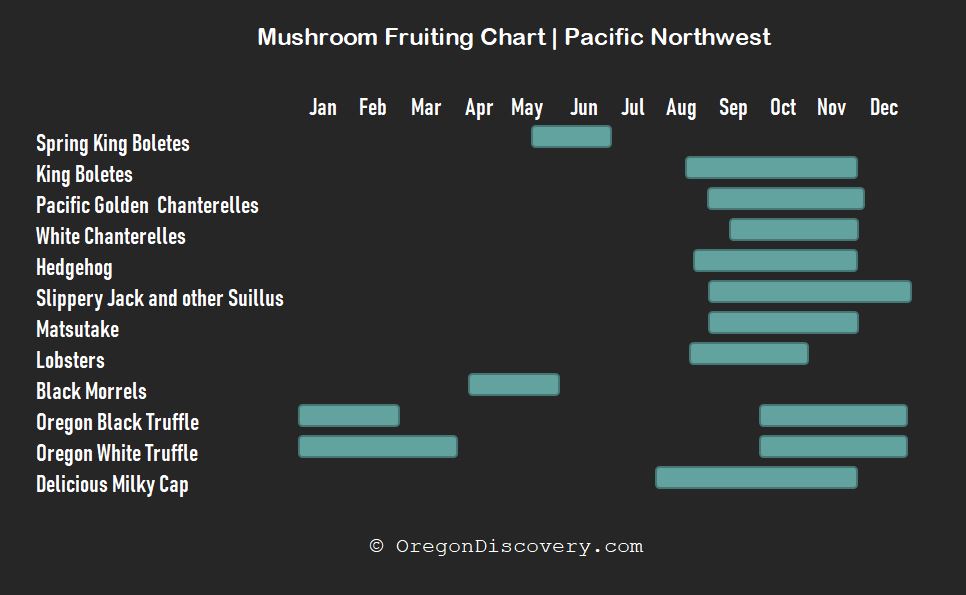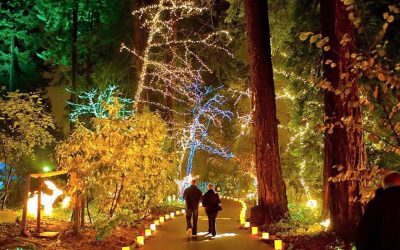Oregon provides the perfect environment to nurture dozens of edible wild mushroom varieties. What’s more, fall is the ideal season to head off on a foraging expedition of your own! As the rains return and the cool autumn air settles in, the forests burst to life with the wide array of mushrooms that Oregon is so well-known for.
Before you venture out, take a moment to learn some key details that will make your collecting experience not only enjoyable but also safe. Mushroom foraging, especially for beginners, comes with the golden rule: absolute caution. While Oregon boasts many delicious and edible mushroom species, the state is also home to several toxic varieties. That’s why it’s crucial to know what you’re picking and to take your time when identifying your finds.
Caution First: Avoiding Toxic Look-Alikes

One of the most dangerous pitfalls in mushroom foraging is mistaking a toxic variety for an edible one. This is where having an expert, or at least a good mushroom guide, comes in handy. Amanita mushrooms, for example, are notoriously toxic and can look quite similar to edible species, such as the prized Caesar’s mushroom.
The safest advice when mushroom hunting is to avoid anything suspicious and always cross-reference with a reliable guidebook. For beginners, I highly recommend, “All That the Rain Promises and More” by David Arora—a pocket guide that’s perfect for identifying mushrooms commonly found in the Pacific Northwest.
Where To Find Fall Mushrooms in Oregon

Different mushrooms thrive under specific trees and prefer particular soil conditions. As a forager, learning which trees to look for can greatly improve your chances of finding the right mushrooms. Here’s a quick guide to pairing trees with fungi:
- Douglas fir: You’ll find boletes (including porcini), chanterelles, and morels growing beneath these trees.
- Pine: Look for hedgehog mushrooms, slippery jacks, matsutakes, and chanterelles.
- Oak: This tree supports boletes, chanterelles, honey mushrooms, and black trumpets.
- Hemlock: One of the best trees for foraging chanterelles, matsutakes, and boletes.
- Sitka spruce: Often home to chanterelles and slippery jacks.
- Aspen: Known for housing honey mushrooms and oysters.
- Birch: Can yield chanterelles and hedgehogs.
Fall is particularly fruitful for foragers due to the combination of rainfall and cooler temperatures, which create the ideal environment for mushrooms to grow. In Oregon, mushrooms often pop up in abundance after the first heavy rains, making mid-September through November prime mushroom-hunting months.
Where And When To Hunt For Mushrooms

In the heart of Oregon’s lush, temperate rainforests, trees like Douglas firs, cedars, and bigleaf maples create a rich, decaying forest floor known as "duff." This nutrient-dense layer not only nourishes trees but also provides the perfect habitat for mushrooms to flourish. There’s something truly magical about kneeling down, running your hands through the earthy forest floor, and discovering golden chanterelles or hearty porcini just waiting to be picked.

Great places to start your foraging adventure include the Tillamook State Forest and the Siuslaw National Forest along the coast. These areas are rich with mossy, damp forest floors, which are exactly what mushrooms love. The Mount Hood National Forest and the Willamette National Forest are also fantastic foraging spots, especially if you're on the lookout for porcini, matsutakes, or chanterelles.
Make sure to check for any local collection regulations—many national forests, like Mount Hood National Forest, have set guidelines for recreational mushroom foraging. Some areas may require permits, and there may be limits on the amount you’re allowed to collect for personal use.
Oregon’s Edible Fall Mushrooms

Here are some of the most commonly sought-after edible mushrooms in Oregon’s forests:
- Chanterelle
- Oregon’s official state mushroom, the Pacific Golden Chanterelle, is a true treasure. With its golden hue, meaty texture, and delicate apricot aroma, chanterelles are both a culinary delight and a joy to find in the wild. You’ll often spot them growing under Douglas fir, hemlock, and spruce trees, especially in mossy areas.
- Morel
- Though more commonly associated with spring, morels can sometimes be found in the fall, especially after forest fires. With their honeycomb-like appearance and rich, nutty flavor, morels are a true prize for any forager.
- Matsutake
- Matsutakes are highly sought after in Japan, where they symbolize fertility and good fortune. They have a strong, spicy aroma and are found under pine trees in Oregon. While their flavor can be polarizing (some love it, others don’t), they are considered a delicacy around the world.

- Porcini (Bolete)
- Known as the King Bolete, porcini mushrooms are one of the most popular edible mushrooms in Oregon. Their meaty texture and savory flavor make them perfect for sautéing, drying, or adding to pasta dishes. Porcini mushrooms tend to grow in association with coniferous trees, and they’re relatively easy to spot.
- Lobster Mushroom
- Lobster mushrooms aren’t actually mushrooms—they’re parasitized fungi. Their striking red-orange color and seafood-like flavor make them a unique addition to any dish. Look for them in forests rich with conifer trees.
- Chicken of the Woods
- With its bright orange color and chicken-like texture, Chicken of the Woods is an excellent meat substitute in vegetarian dishes. You’ll find it growing on the sides of trees, often in large clusters.

- Cauliflower Mushroom
- This rare, coral-like mushroom can grow up to 16 pounds and is known for its noodle-like texture, which makes it a perfect addition to soups and stews.
Truffles: Oregon’s Hidden Gold

No mushroom foraging guide in Oregon would be complete without mentioning truffles. Oregon black and white truffles are some of the most sought-after culinary delicacies in the world.

These subterranean fungi grow at the base of Douglas fir trees, and while they're difficult to find without the help of a trained dog, their musky, garlicky aroma makes them worth the hunt. Truffles can fetch incredibly high prices, sometimes over $300 per pound, making them one of Oregon’s hidden riches.
A Few Safety Tips For Foraging

- Don’t forage alone: If you’re new to mushroom hunting, go with someone experienced, or take a class on mushroom identification.
- Bring a basket and knife: Use a woven basket to carry your finds, as it helps spread mushroom spores for future growth. A small knife is handy for cleanly cutting mushrooms at the base.
- Check the weather: Oregon’s forests can get wet and slippery, so wear proper hiking shoes and be prepared for rain.
- Know your limits: Some areas restrict how much you can collect. Be respectful of these limits to help preserve the forest’s ecosystem.
- Double-check: Never eat a mushroom unless you are absolutely sure it’s safe! If in doubt, throw it out!
Please remember to forage responsibly and always prioritize safety. Happy hunting!













